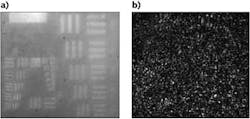BIOMEDICAL IMAGING: Random laser produces speckle-free images

Random lasers may have a future in imaging. A team at Yale University (New Haven, CT) who last year made random lasers with low spatial coherence has now used those low-coherence lasers for speckle-free imaging. The demonstration could open the door to new laser applications in biological imaging, picoprojectors, and cinema projectors.
A byproduct of coherence, laser speckle is a shifting pattern of bright and dark zones produced when a laser beam passes through a scattering medium. It’s tolerable in many laser applications, but speckle degrades images recorded in laser light or displayed by laser projectors.
“Speckle is a random grainy pattern, which is really bad for human perception because you tend to focus on it,” says Yale physicist Hui Cao. Speckle is a particular problem for medical imaging, because it hides details that doctors need to see. Even superluminescent sources generate speckle, so most imaging systems use incoherent lamps or LEDs despite their lower brightnesses.
The first to demonstrate random lasing in a disordered material, Cao has worked on random lasers for more than a dozen years. What is unusual about random lasers is that they lack cavity mirrors, and rely on light scattering from particles distributed through the laser medium to sustain oscillation. They have been demonstrated in a variety of materials, including laser dyes and semiconductors, but until last year they always produced coherent output.
Speckle and OCT
Cao began exploring ways to reduce coherence after talking with Michael Choma, an imaging specialist at Yale’s medical school, about the problems speckle noise caused in his work on optical coherence tomography (OCT). “That led us to wonder if a random laser could be used,” Cao says.
With postdoctoral researcher Brandon Redding, Cao and Choma explored ways to reduce coherence of random lasers. Working with 240-nm-diameter polystyrene spheres dispersed in a laser-dye solution, they explored effects of varying the density of the light-scattering spheres and the size and shape of the laser medium pumped with 532 nm pulses. They found that increasing the pump area and decreasing the distance between scatterers increased the number of laser modes, reducing spatial coherence. The study, published last year, also showed how to design random lasers to reduce their coherence.1
Now they report achieving speckle-free imaging by tuning their random laser to emit with low spatial coherence.2 A series of experiments compared images of objects illuminated by their low-coherence random laser to images recorded with illumination by LEDs, amplified spontaneous emission, a broadband laser, and a narrowband laser. In all cases reported, sharpness of the random laser image was second only to that of the LED image, and markedly better than those recorded with amplified spontaneous emission or other laser sources.
The results are good news for biomedical imaging because brighter laser sources open new options, such as imaging objects that are moving or changing. “Your light source really defines the boundaries of what you can do—how fast you can image,” says Choma. “And you always want to go faster.” Speckle-free lasers also are attractive for laser projection. Laser movie projectors now require moving optical elements to average out speckle; random lasers could avoid that complexity.
After demonstrating incoherent imaging with the random laser, Cao says they want to show they can remove coherent artifacts from a coherent imaging process, OCT, Choma’s original goal. She also wants to develop more practical low-coherence random lasers, such as a semiconductor with quantum dots and random air holes, or a photonic-crystal fiber. And she is thinking about ways to adjust random lasers so they are coherent enough to make a hologram, but not so coherent that they produce speckle.
Chris Dainty of the National University of Ireland (Galway, Ireland) calls the demonstration “an impressive achievement,” but cautions that reducing laser coherence comes at the cost of increasing beam divergence and reducing brightness. Joseph Goodman of Stanford University (Stanford, CA) agrees the speckle-free laser is newsworthy, but adds that it will have to compete with other speckle-reduction techniques such as moving diffusers. Goodman has just described how a stationary multimode fiber could reduce speckle in large laser projectors.3
REFERENCES
1. B. Redding et al., Opt. Lett., 36, 3404 (Sept. 1, 2011).
2. B. Redding et al., Nat. Photon. (advance online publication, (Apr. 29, 2012); doi:10.1038/NPHOTON.2012.90.
3. J. Manni and J. Goodman, Opt. Exp., 20, 11288 (2012).
About the Author
Jeff Hecht
Contributing Editor
Jeff Hecht is a regular contributing editor to Laser Focus World and has been covering the laser industry for 35 years. A prolific book author, Jeff's published works include “Understanding Fiber Optics,” “Understanding Lasers,” “The Laser Guidebook,” and “Beam Weapons: The Next Arms Race.” He also has written books on the histories of lasers and fiber optics, including “City of Light: The Story of Fiber Optics,” and “Beam: The Race to Make the Laser.” Find out more at jeffhecht.com.
